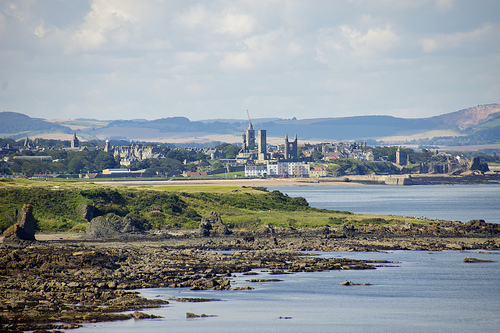St Andrew’s
There has been a settlement here in the location of St Andrews for centuries; evidence has shown that there were people living here in the dark ages; although they were not living in St Andrews as the area was then known as Kilrimont. St Andrew’s University was built here in 1413 making it the first and oldest university in Scotland. The 1400’s saw another first taking place here too; this is where the sport of golf was born. Originally based around a croquet type game it developed into a game with a style of its own and by 1457 the rules of the game were established, rules which have changed little across the centuries. So popular was this new game that the king tried to have it banned, claiming that it took a man’s attention away from the practice of more useful sports, such as archery. Needless to say the ban by James II was pretty much ignored.

Golf at St Andrew’s
By 1754 the game had gone global with the formation of ‘The Society of St Andrew’s Golfers’, which then became the ‘Royal and Ancient Golf Club’ in 1834, the name by which it is still known. The courses here are world famous and see visitors coming to take to the fairways from right around the globe, as such there are many golf and golfing memorabilia outlets in the town, as well as the highly acclaimed British Golfing Museum. Despite being most well known for its golfing heritage there is much more going on in St Andrew’s than people hitting a ball with a stick in an effort to get it to drop into a hole.
The Town of St Andrews
The town grew out of the university, the ancient medieval streets winding their way around the university colleges. If it were not for the university here the town would never have grown the way that it has. Aside from the university influencing the development of the town the Church of Scotland also had great impact. The town was home to what was the biggest cathedral in Scotland, the ruins of which overlook the dramatic coastline and offer a wealth of photographic opportunities. Along with the cathedral came St Andrew’s Castle, built to accommodate the bishops of the cathedral and further highlighting the importance of the town and the role the church played in life in Scotland at that time.
Modern St Andrew’s
Much of the way the modern town looks is the result of works ordered by the Provost, Hugh Playfair who ordered that the streets be made wider, the harbour be improved and the university expanded. Today the town still reflects his redesign. There is much more to St Andrew’s than golf; with the cathedral ruins, the castle and the medieval and Victorian streets, it is a town filled with history and character. St Andrew’s Aquarium and the botanical gardens add extra interest to this already attractive town, and when you have seen and done everything else there is still the beach to enjoy.


